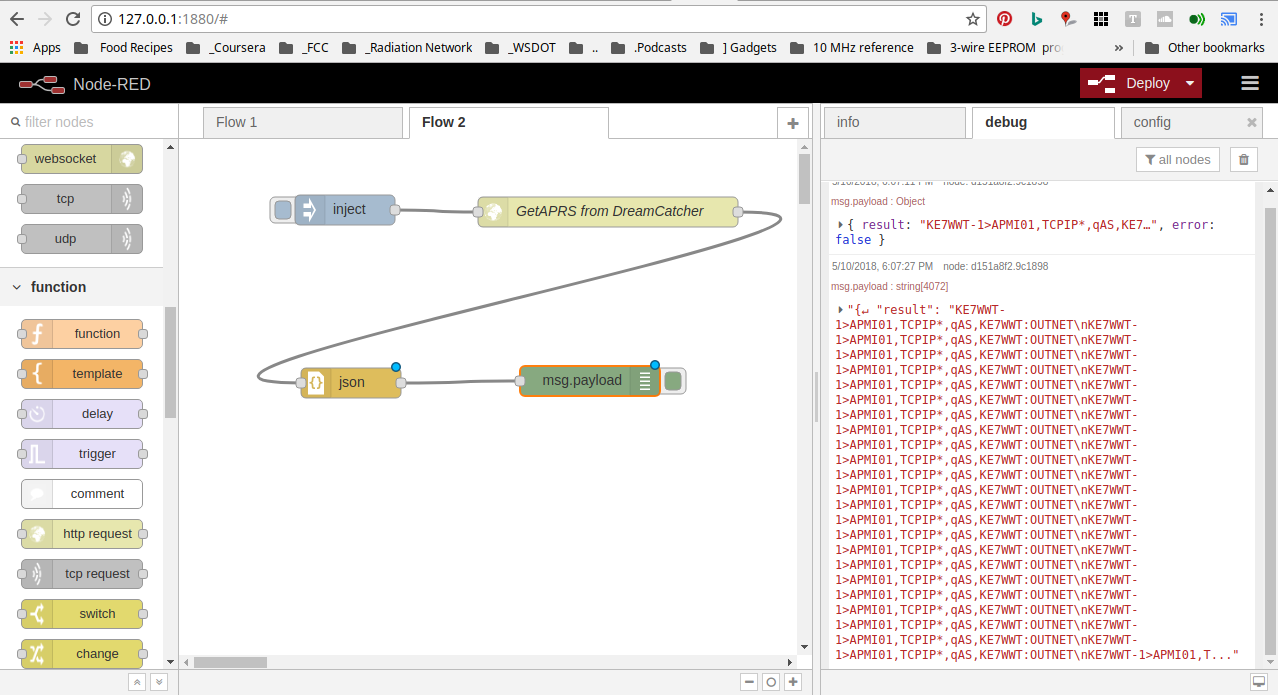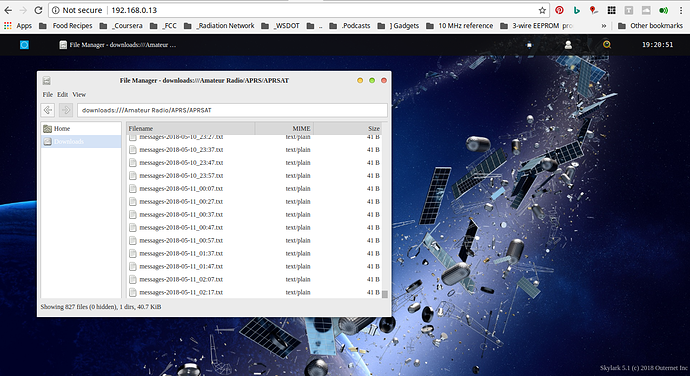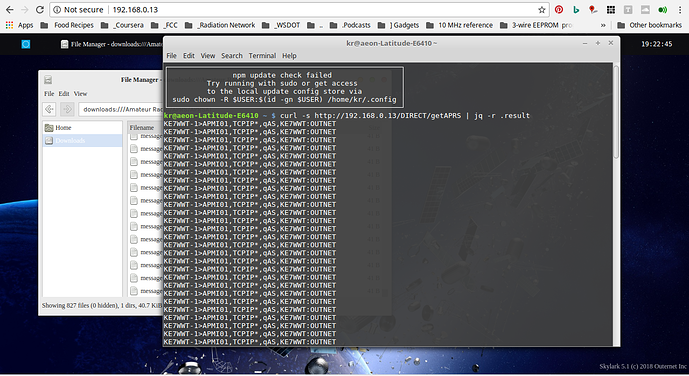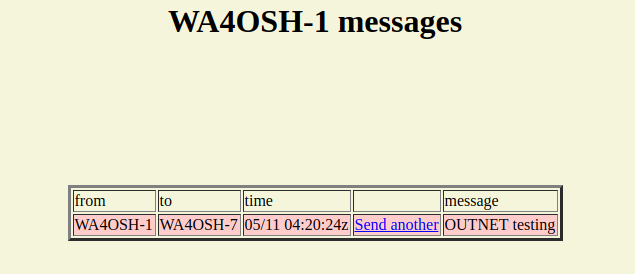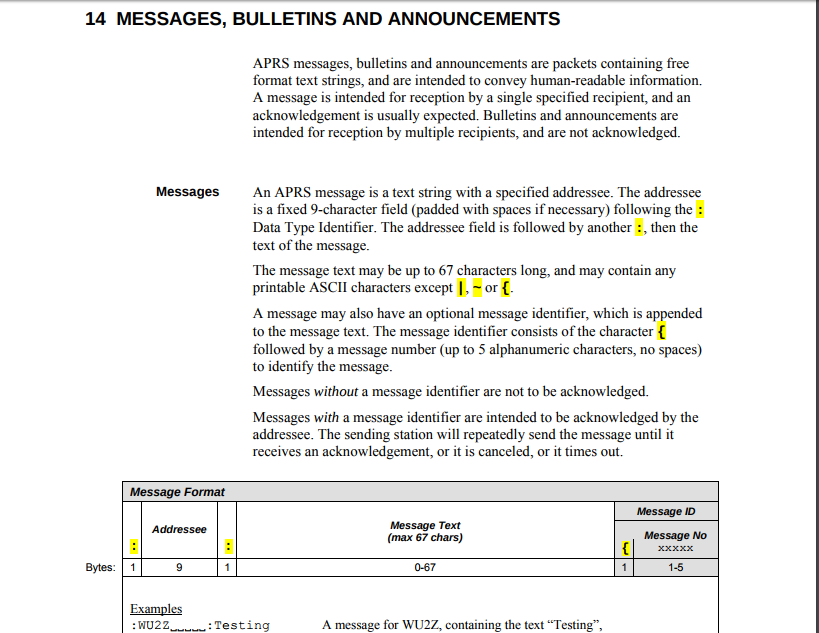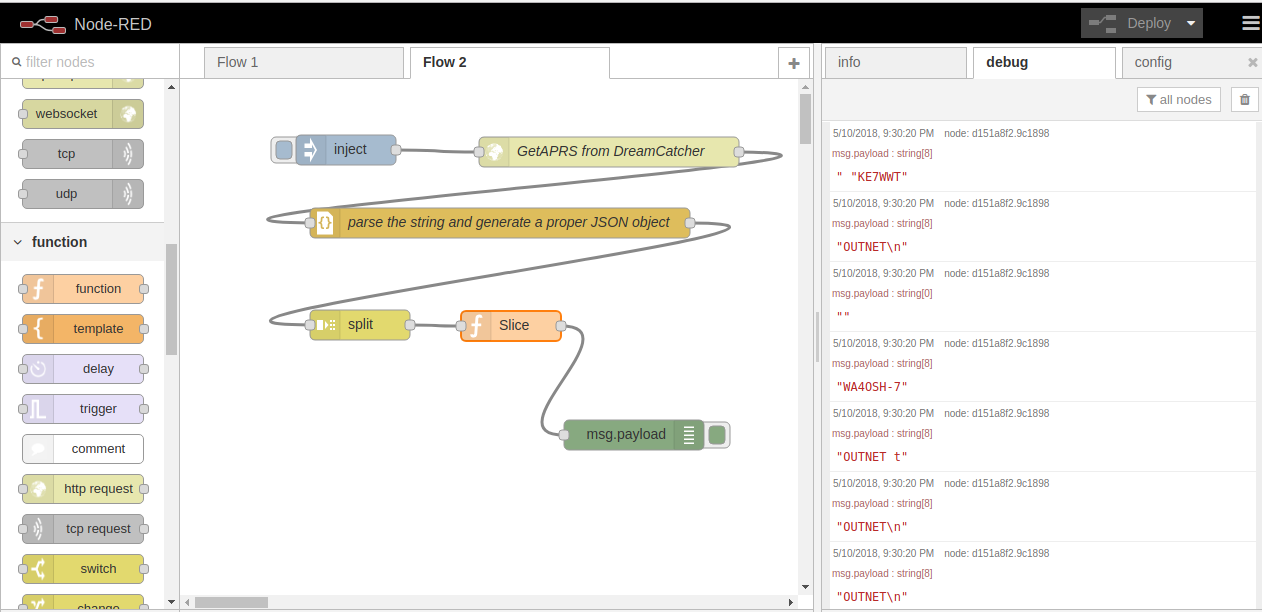@Syed
Someone’s reading the forum. When I mentioned that you send a message up to the ISS and then into the APRS database and then back up through SES-2/Outernet, several people had to test it. Check this out:
KC4JIR-10>APU25N,qAR,W4JML-5:KC4JIR-10>APU25N,qAR,AE4XO::APOUT :Hello DE KC4JIR via OUTNET{00
KC4JIR-10>APJYC1,qAR,W4JML-5:KC4JIR-10>APJYC1,OUTNET,qAR,AE4XO::KC4JIR-10:73 DE KC4JIR-10, Middle GA{m0004
KC4JIR-10>APJYC1,qAR,W4JML-5:KC4JIR-10>APJYC1,OUTNET,qAR,AE4XO::KC4JIR-10:73 DE KC4JIR-10, Middle GA{m0003
KF7VII>APDR13,qAR,W4JML-5:KF7VII>APDR13,TCPIP*,qAC,T2GB::OUTNET :Hello, from north Idaho. sent 1237pm Pacific, Sunday{1
KI6WJP-10>APZP22,qAR,W4JML-5:KI6WJP-10>APZP22,TCPIP*,qAC,T2EDM::KI6WJP-3 :Test to yaac 12:53 via OUTNET
KC4JIR-10>APJYC1,qAR,W4JML-5:KC4JIR-10>APJYC1,OUTNET,qAR,AE4XO::KC4JIR-10:73 DE KC4JIR-10, Middle GA{m0002
M0KNC-3>APSK20,qAR,W4JML-5:M0KNC-3>APSK20,WIDE1-1,qAR,OE3PDB-3::APOUT : test to outernet from 10Mhz three OUTNET{8
M0KNC-3>APSK63,qAR,W4JML-5:M0KNC-3>APSK63,OE3MZC-9,qAR,OE3PDB-3::APOUT : test to outernet from 10Mhz OUTNET{5
KI6WJP-10>APZP22,qAR,W4JML-5:KI6WJP-10>APZP22,TCPIP*,qAC,T2CAEAST::KI6WJP-3 :Test to yaac via OUTNET
WXBOT>APOUT,qAR,W4JML-5:WXBOT>APOUT,OUTNET,qAS,KI6WJP::KI6WJP-10:High 44F
WXBOT>APOUT,qAR,W4JML-5:WXBOT>APOUT,OUTNET,qAS,KI6WJP::KI6WJP-10:Mount Shasta CA. Wednesday,Slight Chance Rain then Rain Likely 60%
RS0ISS>CQ,qAR,W4JML-5:RS0ISS>CQ,qAR,W9PAT:>ARISS - International Space Station
W6MMS>APJYC1,qAR,W4JML-5:W6MMS>APJYC1,TCPIP*,qAC,T2IAD::APOUT :Hello OUTNET! 31 Jan at 0307 UTC{M0001
RS0ISS>CQ,qAR,W4JML-5:RS0ISS>CQ,qAR,WA8LMF-SG:>ARISS - International Space Station
RS0ISS>CQ,qAR,W4JML-5:RS0ISS>CQ,qAR,VK5ASF:>ARISS - International Space Station
KE7WWT-1>APMI01,TCPIP*,qAS,KE7WWT:OUTNET
KC4JIR-10>APU25N,qAR,W4JML-5:KC4JIR-10>APU25N,qAR,AE4XO::APOUT :Hello DE KC4JIR via OUTNET{00
KC4JIR-10>APJYC1,qAR,W4JML-5:KC4JIR-10>APJYC1,OUTNET,qAR,AE4XO::KC4JIR-10:73 DE KC4JIR-10, Middle GA{m0004
KC4JIR-10>APJYC1,qAR,W4JML-5:KC4JIR-10>APJYC1,OUTNET,qAR,AE4XO::KC4JIR-10:73 DE KC4JIR-10, Middle GA{m0003
KF7VII>APDR13,qAR,W4JML-5:KF7VII>APDR13,TCPIP*,qAC,T2GB::OUTNET :Hello, from north Idaho. sent 1237pm Pacific, Sunday{1
KI6WJP-10>APZP22,qAR,W4JML-5:KI6WJP-10>APZP22,TCPIP*,qAC,T2EDM::KI6WJP-3 :Test to yaac 12:53 via OUTNET
KC4JIR-10>APJYC1,qAR,W4JML-5:KC4JIR-10>APJYC1,OUTNET,qAR,AE4XO::KC4JIR-10:73 DE KC4JIR-10, Middle GA{m0002
M0KNC-3>APSK20,qAR,W4JML-5:M0KNC-3>APSK20,WIDE1-1,qAR,OE3PDB-3::APOUT : test to outernet from 10Mhz three OUTNET{8
M0KNC-3>APSK63,qAR,W4JML-5:M0KNC-3>APSK63,OE3MZC-9,qAR,OE3PDB-3::APOUT : test to outernet from 10Mhz OUTNET{5
KI6WJP-10>APZP22,qAR,W4JML-5:KI6WJP-10>APZP22,TCPIP*,qAC,T2CAEAST::KI6WJP-3 :Test to yaac via OUTNET
WXBOT>APOUT,qAR,W4JML-5:WXBOT>APOUT,OUTNET,qAS,KI6WJP::KI6WJP-10:High 44F
WXBOT>APOUT,qAR,W4JML-5:WXBOT>APOUT,OUTNET,qAS,KI6WJP::KI6WJP-10:Mount Shasta CA. Wednesday,Slight Chance Rain then Rain Likely 60%
RS0ISS>CQ,qAR,W4JML-5:RS0ISS>CQ,qAR,W9PAT:>ARISS - International Space Station
W6MMS>APJYC1,qAR,W4JML-5:W6MMS>APJYC1,TCPIP*,qAC,T2IAD::APOUT :Hello OUTNET! 31 Jan at 0307 UTC{M0001
RS0ISS>CQ,qAR,W4JML-5:RS0ISS>CQ,qAR,WA8LMF-SG:>ARISS - International Space Station
RS0ISS>CQ,qAR,W4JML-5:RS0ISS>CQ,qAR,VK5ASF:>ARISS - International Space Station
KC4JIR-10>APU25N,qAR,W4JML-5:KC4JIR-10>APU25N,qAR,AE4XO::APOUT :Hello DE KC4JIR via OUTNET{00
KC4JIR-10>APJYC1,qAR,W4JML-5:KC4JIR-10>APJYC1,OUTNET,qAR,AE4XO::KC4JIR-10:73 DE KC4JIR-10, Middle GA{m0004
KC4JIR-10>APJYC1,qAR,W4JML-5:KC4JIR-10>APJYC1,OUTNET,qAR,AE4XO::KC4JIR-10:73 DE KC4JIR-10, Middle GA{m0003
KF7VII>APDR13,qAR,W4JML-5:KF7VII>APDR13,TCPIP*,qAC,T2GB::OUTNET :Hello, from north Idaho. sent 1237pm Pacific, Sunday{1
KI6WJP-10>APZP22,qAR,W4JML-5:KI6WJP-10>APZP22,TCPIP*,qAC,T2EDM::KI6WJP-3 :Test to yaac 12:53 via OUTNET
KC4JIR-10>APJYC1,qAR,W4JML-5:KC4JIR-10>APJYC1,OUTNET,qAR,AE4XO::KC4JIR-10:73 DE KC4JIR-10, Middle GA{m0002
M0KNC-3>APSK20,qAR,W4JML-5:M0KNC-3>APSK20,WIDE1-1,qAR,OE3PDB-3::APOUT : test to outernet from 10Mhz three OUTNET{8
M0KNC-3>APSK63,qAR,W4JML-5:M0KNC-3>APSK63,OE3MZC-9,qAR,OE3PDB-3::APOUT : test to outernet from 10Mhz OUTNET{5
KI6WJP-10>APZP22,qAR,W4JML-5:KI6WJP-10>APZP22,TCPIP*,qAC,T2CAEAST::KI6WJP-3 :Test to yaac via OUTNET
WXBOT>APOUT,qAR,W4JML-5:WXBOT>APOUT,OUTNET,qAS,KI6WJP::KI6WJP-10:High 44F
WXBOT>APOUT,qAR,W4JML-5:WXBOT>APOUT,OUTNET,qAS,KI6WJP::KI6WJP-10:Mount Shasta CA. Wednesday,Slight Chance Rain then Rain Likely 60%
RS0ISS>CQ,qAR,W4JML-5:RS0ISS>CQ,qAR,W9PAT:>ARISS - International Space Station
W6MMS>APJYC1,qAR,W4JML-5:W6MMS>APJYC1,TCPIP*,qAC,T2IAD::APOUT :Hello OUTNET! 31 Jan at 0307 UTC{M0001
RS0ISS>CQ,qAR,W4JML-5:RS0ISS>CQ,qAR,WA8LMF-SG:>ARISS - International Space Station
RS0ISS>CQ,qAR,W4JML-5:RS0ISS>CQ,qAR,VK5ASF:>ARISS - International Space Station
KC4JIR-10>APU25N,qAR,W4JML-5:KC4JIR-10>APU25N,qAR,AE4XO::APOUT :Hello DE KC4JIR via OUTNET{00
KC4JIR-10>APJYC1,qAR,W4JML-5:KC4JIR-10>APJYC1,OUTNET,qAR,AE4XO::KC4JIR-10:73 DE KC4JIR-10, Middle GA{m0004
KC4JIR-10>APJYC1,qAR,W4JML-5:KC4JIR-10>APJYC1,OUTNET,qAR,AE4XO::KC4JIR-10:73 DE KC4JIR-10, Middle GA{m0003
KF7VII>APDR13,qAR,W4JML-5:KF7VII>APDR13,TCPIP*,qAC,T2GB::OUTNET :Hello, from north Idaho. sent 1237pm Pacific, Sunday{1
KI6WJP-10>APZP22,qAR,W4JML-5:KI6WJP-10>APZP22,TCPIP*,qAC,T2EDM::KI6WJP-3 :Test to yaac 12:53 via OUTNET
KC4JIR-10>APJYC1,qAR,W4JML-5:KC4JIR-10>APJYC1,OUTNET,qAR,AE4XO::KC4JIR-10:73 DE KC4JIR-10, Middle GA{m0002
M0KNC-3>APSK20,qAR,W4JML-5:M0KNC-3>APSK20,WIDE1-1,qAR,OE3PDB-3::APOUT : test to outernet from 10Mhz three OUTNET{8
M0KNC-3>APSK63,qAR,W4JML-5:M0KNC-3>APSK63,OE3MZC-9,qAR,OE3PDB-3::APOUT : test to outernet from 10Mhz OUTNET{5
KI6WJP-10>APZP22,qAR,W4JML-5:KI6WJP-10>APZP22,TCPIP*,qAC,T2CAEAST::KI6WJP-3 :Test to yaac via OUTNET
WXBOT>APOUT,qAR,W4JML-5:WXBOT>APOUT,OUTNET,qAS,KI6WJP::KI6WJP-10:High 44F
WXBOT>APOUT,qAR,W4JML-5:WXBOT>APOUT,OUTNET,qAS,KI6WJP::KI6WJP-10:Mount Shasta CA. Wednesday,Slight Chance Rain then Rain Likely 60%
RS0ISS>CQ,qAR,W4JML-5:RS0ISS>CQ,qAR,W9PAT:>ARISS - International Space Station
W6MMS>APJYC1,qAR,W4JML-5:W6MMS>APJYC1,TCPIP*,qAC,T2IAD::APOUT :Hello OUTNET! 31 Jan at 0307 UTC{M0001
RS0ISS>CQ,qAR,W4JML-5:RS0ISS>CQ,qAR,WA8LMF-SG:>ARISS - International Space Station
RS0ISS>CQ,qAR,W4JML-5:RS0ISS>CQ,qAR,VK5ASF:>ARISS - International Space Station
KE7WWT-1>APMI01,TCPIP*,qAS,KE7WWT:OUTNET
KE7WWT-1>APMI01,TCPIP*,qAS,KE7WWT:OUTNET
KC4JIR-10>APU25N,qAR,W4JML-5:KC4JIR-10>APU25N,qAR,AE4XO::APOUT :Hello DE KC4JIR via OUTNET{00
KC4JIR-10>APJYC1,qAR,W4JML-5:KC4JIR-10>APJYC1,OUTNET,qAR,AE4XO::KC4JIR-10:73 DE KC4JIR-10, Middle GA{m0004
KC4JIR-10>APJYC1,qAR,W4JML-5:KC4JIR-10>APJYC1,OUTNET,qAR,AE4XO::KC4JIR-10:73 DE KC4JIR-10, Middle GA{m0003
KF7VII>APDR13,qAR,W4JML-5:KF7VII>APDR13,TCPIP*,qAC,T2GB::OUTNET :Hello, from north Idaho. sent 1237pm Pacific, Sunday{1
KI6WJP-10>APZP22,qAR,W4JML-5:KI6WJP-10>APZP22,TCPIP*,qAC,T2EDM::KI6WJP-3 :Test to yaac 12:53 via OUTNET
KC4JIR-10>APJYC1,qAR,W4JML-5:KC4JIR-10>APJYC1,OUTNET,qAR,AE4XO::KC4JIR-10:73 DE KC4JIR-10, Middle GA{m0002
M0KNC-3>APSK20,qAR,W4JML-5:M0KNC-3>APSK20,WIDE1-1,qAR,OE3PDB-3::APOUT : test to outernet from 10Mhz three OUTNET{8
M0KNC-3>APSK63,qAR,W4JML-5:M0KNC-3>APSK63,OE3MZC-9,qAR,OE3PDB-3::APOUT : test to outernet from 10Mhz OUTNET{5
KI6WJP-10>APZP22,qAR,W4JML-5:KI6WJP-10>APZP22,TCPIP*,qAC,T2CAEAST::KI6WJP-3 :Test to yaac via OUTNET
WXBOT>APOUT,qAR,W4JML-5:WXBOT>APOUT,OUTNET,qAS,KI6WJP::KI6WJP-10:High 44F
WXBOT>APOUT,qAR,W4JML-5:WXBOT>APOUT,OUTNET,qAS,KI6WJP::KI6WJP-10:Mount Shasta CA. Wednesday,Slight Chance Rain then Rain Likely 60%
RS0ISS>CQ,qAR,W4JML-5:RS0ISS>CQ,qAR,W9PAT:>ARISS - International Space Station
W6MMS>APJYC1,qAR,W4JML-5:W6MMS>APJYC1,TCPIP*,qAC,T2IAD::APOUT :Hello OUTNET! 31 Jan at 0307 UTC{M0001
RS0ISS>CQ,qAR,W4JML-5:RS0ISS>CQ,qAR,WA8LMF-SG:>ARISS - International Space Station
RS0ISS>CQ,qAR,W4JML-5:RS0ISS>CQ,qAR,VK5ASF:>ARISS - International Space Station
KE7WWT-1>APMI01,TCPIP*,qAS,KE7WWT:OUTNET
KE7WWT-1>APMI01,TCPIP*,qAS,KE7WWT:OUTNET
KE7WWT-1>APMI01,TCPIP*,qAS,KE7WWT:OUTNET
KE7WWT-1>APMI01,TCPIP*,qAS,KE7WWT:OUTNET
KE7WWT-1>APMI01,TCPIP*,qAS,KE7WWT:OUTNET
KE7WWT-1>APMI01,TCPIP*,qAS,KE7WWT:OUTNET
KE7WWT-1>APMI01,TCPIP*,qAS,KE7WWT:OUTNET
KE7WWT-1>APMI01,TCPIP*,qAS,KE7WWT:OUTNET
KE7WWT-1>APMI01,TCPIP*,qAS,KE7WWT:OUTNET
KE7WWT-1>APMI01,TCPIP*,qAS,KE7WWT:OUTNET
KE7WWT-1>APMI01,TCPIP*,qAS,KE7WWT:OUTNET
KE7WWT-1>APMI01,TCPIP*,qAS,KE7WWT:OUTNET
KE7WWT-1>APMI01,TCPIP*,qAS,KE7WWT:OUTNET
AC8DG-9>EF0T9T,WIDE1-1,WIDE2-1,qAR,KJ4KFJ-15:qDl"5>/"6N}no spaces abcOUTNETabc_%
AC8DG-9>EF0T9T,WIDE1-1,WIDE2-1,qAR,KJ4KFJ-15:qDl"5>/"6N}146.520MHz w/spaces OUTNET 73_%
KE7WWT-1>APMI01,TCPIP*,qAS,KE7WWT:OUTNET
KE7WWT-1>APMI01,TCPIP*,qAS,KE7WWT:OUTNET
KE7WWT-1>APMI01,TCPIP*,qAS,KE7WWT:OUTNET
AC8DG-9>EF0T9T,WD7LEE-1,WIDE1*,WIDE2-1,qAS,WD8DX:qDl"5>/"6N}146.520MHz outnet OUTNET _%
Congrats for all those that made it a double satellite hop!
You CAN send a message via a 2M packet radio up to ISS, back down to an iGateway. From there to the APRS database When the message has the OUTNET tag, it gets send by Outernet to folks that have a DreamCatcher. Wow.
Thanks guys … You made my day!
Now I’m curious if you can actually direct a message into my “Mailbox” through Outernet. I will have to respond in kind and send a QSL message back to you via ISS or a cubesat when they fly over my QTH.
I will work on a parser to scan the incoming messages for WA4OSH-7, my Outernet “Mailbox”.
This works ok so far to get recent messages from my DreamCatcher with my Linux Laptop:
$ curl -s http://(ip address of my DreamCatcher)/DIRECT/getAPRS | jq -r .result
–Konrad, WA4OSH

